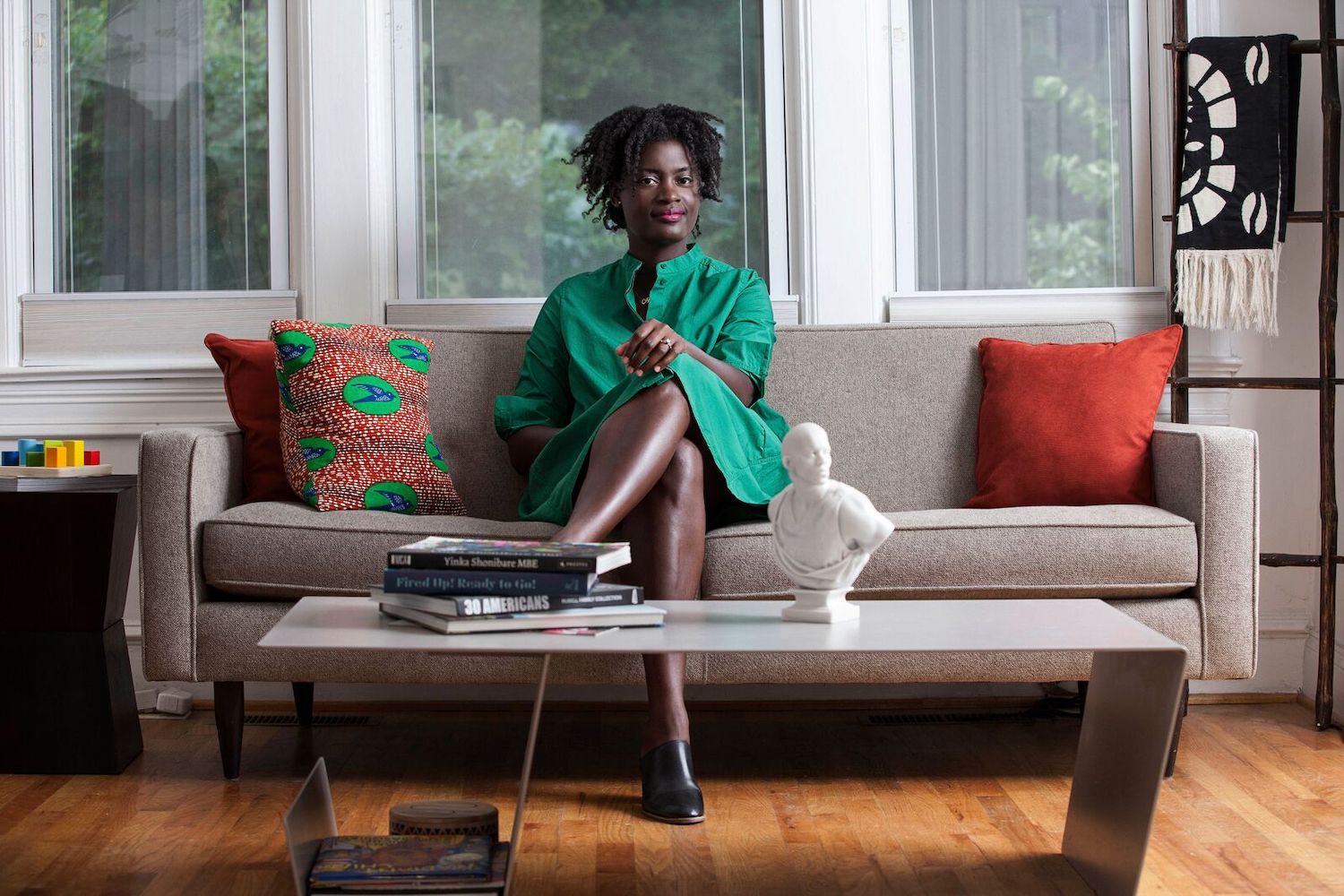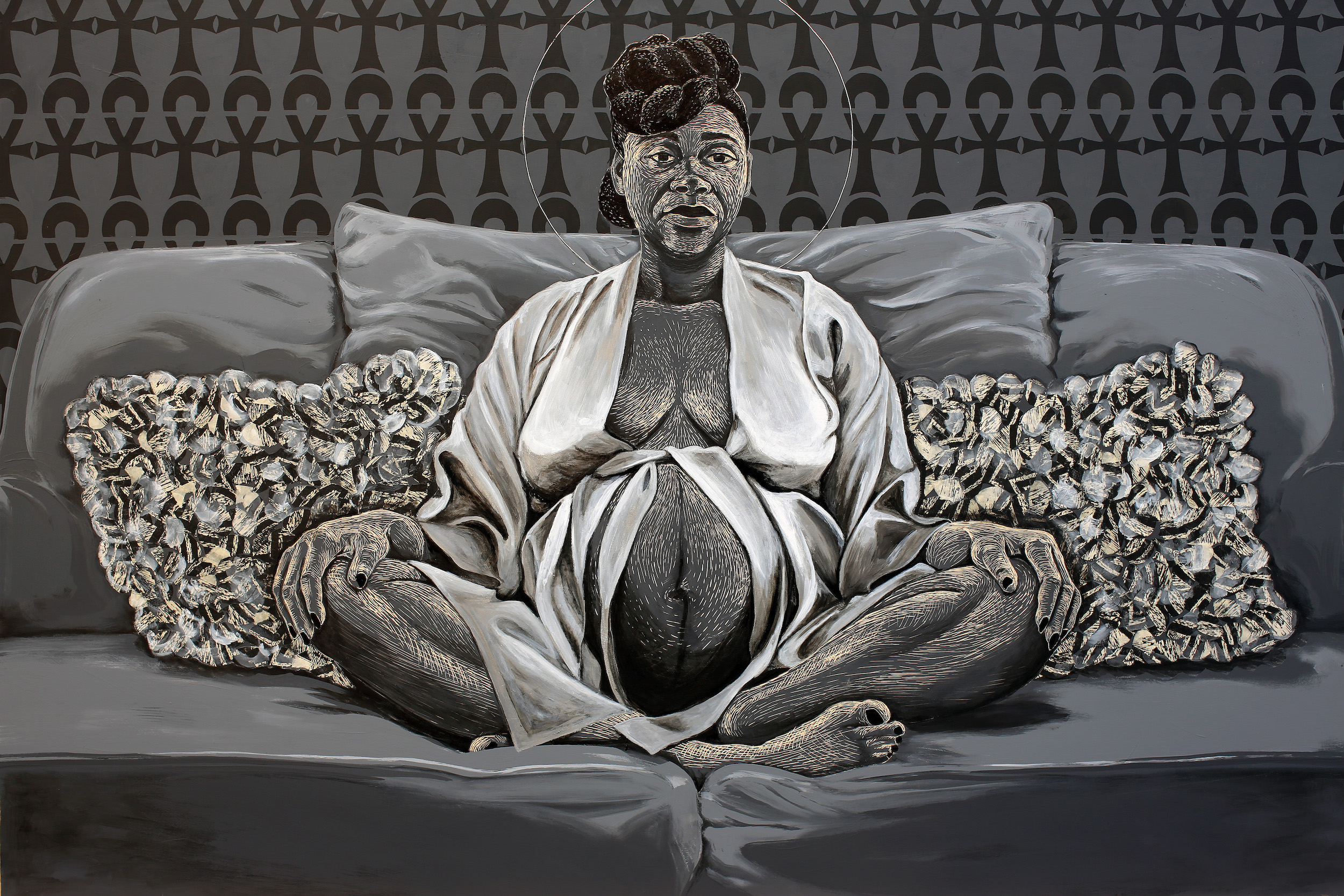Ye are the salt of the earth: but if the salt have lost his savour, wherewith shall it be salted? It is thenceforth good for nothing but to be cast out, and to be trodden under foot of man. –Matthew 5:13
Are you sure, sweetheart, that you want to be well? –Toni Cade Bambara, The Salt Eaters
“There are not enough representations of women just as we are,” said mixed-media artist LaToya Hobbs as we stood in front of her piece “To Stand a Little Taller,” a beautiful oil, acrylic, and collage work exhibited at The Gallery at Baltimore City Hall. I stared up at the portrait of a curly haired woman who smiled back at me with soft eyes. An adinkrahene, a circular Ghanaian adinkra symbol representing greatness and leadership, is replicated in a dense pattern across the canvas and overlays the woman’s black and red dress and the white backdrop behind her. As I looked up at the woman, I thought about how rare it is to see triumphant reflections of Black motherhood.
In her latest exhibition, Salt of the Earth, Hobbs depicts “modern matriarchs,” a series of figurative relief carvings, oil paintings, and lustrous aluminum plates that feature Black mothers in striking and edifying portraits.
“We are put into tropes or stereotypes that limit us as people,” Hobbs continued. “We are vast, and there is a richness that I feel is a part of the tradition of Black womanhood. I really try to show that through my work.”
Those tropes and stereotypes have grave consequences for Black women. A 2017 study by the Centers for Disease Control and Prevention revealed that African American mothers are four times more likely to die in childbirth than white mothers are, and 243 percent more likely to die from childbirth-related causes. In 2018, the Black & Missing Foundation found that 37 percent of missing children under age 17 were Black, and that people of color represented 38 percent of all people reported missing that year. When all of this is compounded by the cruel stance of our political administration to not consider white supremacist violence inflicted onto Black bodies as acts of domestic terrorism, and to rarely prosecute officers who murder Black children, the fact that Black women are not entirely discouraged from starting families is evidence of a determined and unshakable will to survive.

“To Stand a Little Taller,” oil, acrylic, and collage on canvas, 30″ x 24″ (2016)
Curated by Kirk Shannon-Butts, Salt of the Earth is the second iteration in Hobbs’ ongoing portraiture series. The first, Beautiful Uprising, which debuted at the Community Folk Art Center at Syracuse University, considered themes of self esteem, self care, and Black womanhood. Inspired by the Bible verse Matthew 5:13, Salt of the Earth draws corollaries between the roles Black women maintain as the keepers of family and community, and salt, a mineral used as a preservative. In later iterations of the series, Hobbs will consider the counterbalance of salt as it’s used to erode, bleach, and draw out nutrients, in relation to the deprivation of Black women’s self care.
While reflecting on the significance of Matthew 5:13 on this body of work, Hobbs noted, “I see the scripture as being in two phases: [Black women] being the salt of the earth, the preservers of family, culture, and community. The second part of the scripture represents the kind of duality in the Black experience as a woman: the strength that we possess, but also what happens when we are not preserving ourselves, not taking care of ourselves. I think we see that too often, we are cast out. With this body of work, I am trying to show both aspects of that.”
Each portrait exudes an ecstatic resonance, a regality, presence, and dimensionality that deifies the women who are featured, many of whom are the artist’s close friends. They are sisters who have witnessed each other negotiate the joys and exhaustion of motherhood. “It’s a goal of my work to show us in a positive light despite the struggles that may be occurring in our lives,” Hobbs said. Some of the portraits directly engage the viewer’s gaze, while others keep their eyes closed, tilt their heads toward the sky, and daydream.
“Birthing a child and carrying another being in your body is a very spiritual thing.”
We walked over to “Birth of a Mother (Expectation),” a self-portrait the artist rendered while pregnant with her first son. Using acrylic, collage, and relief carving, Hobbs depicts herself sitting in lotus position in the middle of a large sofa; her big belly and bosom protrude through her white robe. Her head is haloed by a thin ring of light. The wall behind her is covered in an intricate pattern of ankhs, an ancient Egyptian symbol for fertility and the balance between feminine and masculine energy. In these intimate scenes, Hobbs presents mothers as angelic personas, and motherhood as a hallowed phenomenon.
“When I found out I was pregnant I got really fearful because I just finished graduate school, moved to Baltimore, had my first real job, and then, it was like, BOOM, you’re pregnant!” Hobbs said. “I wasn’t sure that people would take me seriously as an artist and a mother. You hear lots of stories like that.”
Artists who become mothers are often expected to cast aside their art practice and focus solely on their families—as if they can’t have both. And artists who explore motherhood in their work are often sidelined or even shamed. “I didn’t use to focus on any aspects of maternity in my work, but now I feel like it’s not something that I need to hide or compromise,” she said. “Birthing a child and carrying another being in your body is a very spiritual thing.”

“Portrait of a Mother,” oil, acrylic, and relief carving on wood panel, 72″ x 48″ (2019)
Hobbs’ aesthetic involves myriad techniques, culling African diasporic histories to render Black women and their environments as layered, multidimensional subjects. Hobbs displays the matrix, the surface that is carved and typically used to make prints, as the art. The surgical precision of her relief carvings, a terribly unforgiving process, is exquisite and labor-intensive. Coupled with a vibrant palette of gold, silver, and bronze variations that mimic the sheen of darker skin tones, as well as intricate patterns that incorporate adinkra and kemetic iconography, each portrait is a moving meditation on Black joy.
Black joy is an integral element in Hobbs’ portraits. In “Epiphany,” a beautiful, mahogany-skinned woman wears a gold and ivory dress that glows against a black-on-black matte design, a motif reminiscent West African textiles. A gold headband accents her cropped afro, and the woman smiles as she stares up and out, beyond the frame. Black joy is a defiant and political act, and so is dedicating an exhibition to joyous, adorned, natural-haired Black women.
“How are we deciding what is beautiful in our communities?” Hobbs asks. “How are we as Black women accepting or rejecting that [standard]?”
The beauty standard Hobbs confronts has been like a cancer to the confidence of most women, a daily negotiation that women rise above or succumb to. Salt of the Earth exceeds the expectations placed on Black women to be everything and invisible, as well as the limited presumptions projected onto Black mothers as ever-struggling and rarely supported martyrs. The modern matriarchs in Hobbs’ series are dynamic and affirming, boisterous and unabashedly encouraging portrayals of Black womanhood.
Salt of the Earth is on display at the Baltimore City Hall Gallery through June 14. Hobbs will give a talk about her work on May 16, 6–8 p.m.
Images courtesy of the artist. Featured image: “Birth of a Mother (Expectation),” acrylic, collage, and relief carving on wood panel, 48″ x 72″ (2019)






